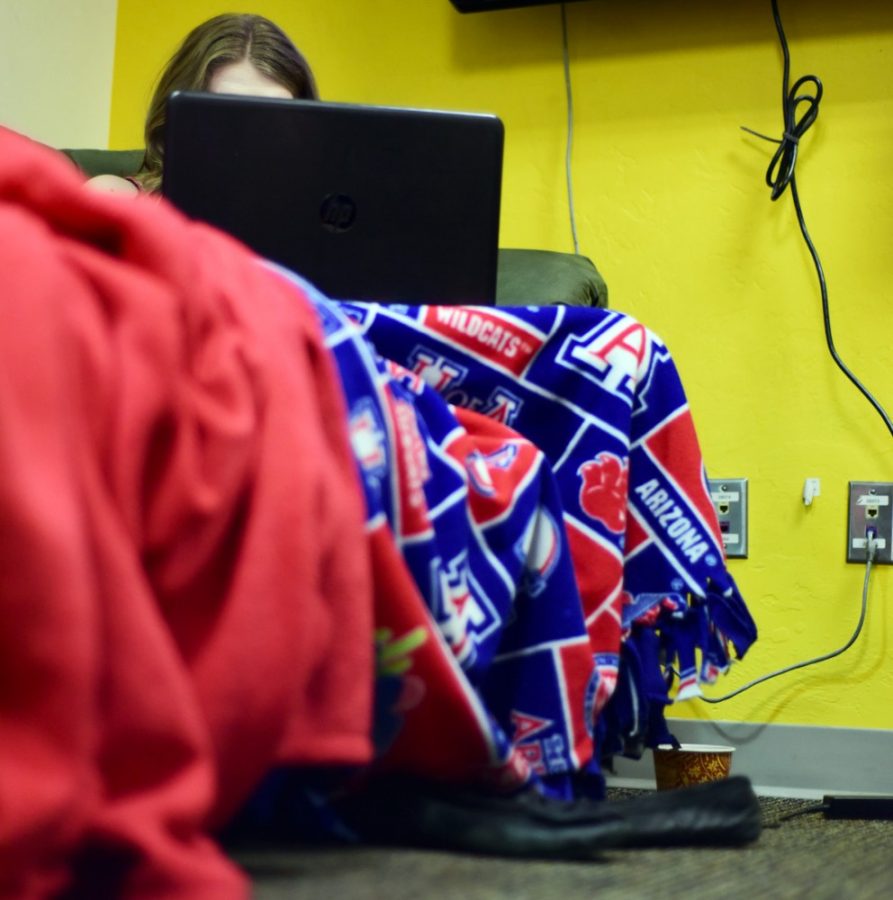At the age of 24, Melody Buckner earned her bachelor’s degree at Arizona State University. After taking a few years off to work and start a family, she wanted to return to school to get her master’s degree. Even though she lived in Tucson, she couldn’t attend the UA due to the time constraints of work and parenting. As a result, she enrolled in Northern Arizona University’s online master’s program and completed her master’s at the age of 42.
Now she’s 54 years old and pursuing her Ph.D. at the UA. She works as the director of Digital Learning Initiatives and Online Education, tasked with the job of developing UA Online, a fully online program in which undergraduate and graduate students can earn their degrees without having to be on campus.
UA Online
Online learning is not new to the UA. Since 2009, the Outreach College has offered online classes to graduate students seeking professional degrees. But, UA Online’s emphasis on helping undergraduate students earn their bachelor’s degrees through fully online courses is new.
Beginning in fall 2015, the UA will offer 24 different online degrees for undergraduate students, 18 for graduate students and 23 for students seeking graduate certificates.
According to Vincent Del Casino, vice provost for Digital Learning and Student Engagement, UA Online is planning to accept 1,000 undergraduate and 2,500 graduate students.
On the surface, UA Online should offer a number of benefits for the UA. Many have been vocal about their support of online learning and the expansion of the UA’s curriculum. However, there are also concerns about the effect the program will have regarding on-campus students, the change it could have on the landscape of the university as a whole, and UA Online’s ability to provide students “with online education that’s equal to the best in-classroom experience,” as advertised.
The Digital Age
The launch of UA Online comes at a timely period in higher education. For years, online learning has seen an unprecedented growth. In addition to the rising popularity of online learning, there is a growing demand for bachelor’s degrees from employers. There are not enough job seekers with bachelor’s degrees, and, as a result, there is a significant credential gap in employment.
According to Burning Glass, a database that tracks millions of online job postings and the credentials employers ask for, the credential gap is above 20 percent in management, office and administrative services, business and financial operations, and computer and mathematical jobs.
“Both the economy and society are demanding an increase in [bachelor’s degrees],” Del Casino said. “We have to meet certain expectations and demands so that we continue to have active, engaged students who can move the state forward.”
Call for expansion
For years, the UA has been an attractive university for undergraduates who want to be on campus and experience the college lifestyle. The university has not been nearly as successful at attracting students 25 years and older. University Analytics & Institutional Research reports that almost 9 percent of undergraduates were 25 years or older in fall 2014. At NAU, 21 percent of undergraduates were above the age of 25. At UCLA and UC Davis, the number was 6 percent.
“The big picture is access,” Del Casino said. “Right now, we’re limited. Geography limits us when you mandate that people move somewhere. Online allows for multiple populations to access that education that [hasn’t] been available before.”
For Buckner, UA Online means more than accessibility. It’s a matter of fairness.
“We don’t want to say, ‘Oh, you can only get a UA degree if you can physically come here and be a part of the resident,’” Buckner said. “Then we get into a bit of a social justice issue, don’t we? This is just a way for us to reach a population that can’t experience college.”
Demand for quality
Some said they believe the expansion of online learning will open up more opportunities for creative learning.
Eliane Rubinstein-Avila, an associate professor for the UA Department of Teaching, Learning and Sociocultural Studies, has seen the high quality education online classes can offer.
“Face-to-face only, I will probably not teach much anymore,” Avila said. “[With online classes,] I can deliver courses that are a lot more multi-modal.”
Avila cites that, too often, a face-to-face class is too text-based. Online classes allow her the flexibility to show films, documentaries and an assortment of videos to complement her teachings.
A study conducted by the U.S. Department of Education in 2010 supports her view. After analyzing more than a thousand empirical studies on online learning, researchers found “students in online conditions performed modestly better, on average, than those learning the same material through traditional face-to-face instruction.”
Yet, others are not as quick to praise the quality of online classes.
“I don’t like online classes,” said Melissa Espindola, a senior studying chemistry and French. “The topics were really interesting, but I feel like, sometimes, when I had questions, I would email my professor, and it was hard for her. I wouldn’t understand her emails sometimes.”
Another student had a similar sentiment, citing the lack of interactivity in an online class.
“It wasn’t something I liked because it was just like, ‘OK, I look at the material, and that’s it,’” said Maria Mata, a sophomore studying family studies and human development. “I need someone to actually see and walk up to ask them something.”
Del Casino shared a more objective view on the matter.
“There’s good teaching, and there’s bad teaching,” he said. “And that can happen in your face-to-face classroom or your online world.”
Meanwhile, Avila said she believes it’s unfair to say one teaching method is better than the other.
“Just because someone is teaching it face-to-face doesn’t make it a quality course, and just because someone teaches it online, it doesn’t make it an inferior course,” Avila said. “I don’t think it’s for everybody or that everybody will do well. It all depends on the quality of the instructor.”
Influence on student population
Financially, UA Online can prove to be a cheap alternative to attending classes on campus. For on-campus classes, it costs $771 per unit. It costs $490-$515 per unit for an online class. This raises the question: Will more students opt to attend UA Online, rather than experience life on campus?
“It’s just a spread of opportunity,” Del Casino said. “None of this is going to stem the tide of people who want to be in Tucson, Arizona. Coming to Tucson, being a student at the University of Arizona, is a special experience.”
Looking toward the future
In five weeks of advertising and marketing, UA Online has already garnered over 100 applicants and over 1,000 views on its website.
“I think things will start to grow as people understand that this is an option,” said Melissa Vito, vice provost for Academic Initiatives and Student Success. “In five years, in my ideal world, we would probably be somewhere around 10,000 graduate and undergraduate students.”
Despite the expected rise in diplomas the UA will hand out in the next few years due to UA Online, Vito and Del Casino said they do not worry about the university turning into a diploma mill.
“We have the same admissions standards, the same degree requirements and the same degree,” Del Casino said. “This is just another way in which we’re investing in the research and practice of teaching and learning.”
_______________
Follow Kethia Kong on Twitter.









